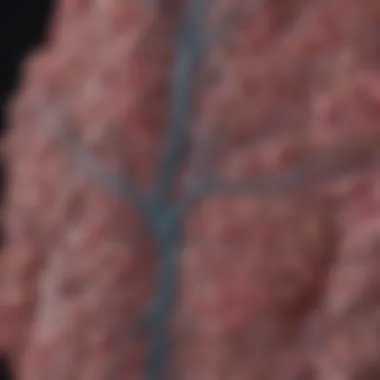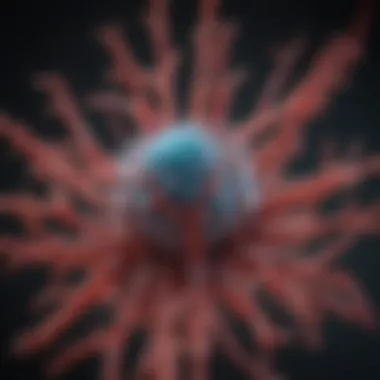Centrin 2 Antibody: Functionality and Applications


Intro
The Centrin 2 antibody has garnered significant attention in the fields of cellular and molecular biology. Understanding it involves looking at its structure and various functions. Researchers are interested in this antibody due to its role in critical biological processes and its application in different experimental setups. This section lays the groundwork for exploring its functionality and applications, ensuring a focused approach to appreciating its relevance in both basic and applied scientific research.
Research Overview
Summary of Key Findings
Centrin 2, a member of the centrin family of proteins, is involved in cellular processes such as cell division and maintaining the structural integrity of the centrosome. The centrin 2 antibody plays an instrumental role in detecting this protein within cells. Studies indicate its involvement in various cellular pathways, unlocking insights into its potential implications for understanding complex diseases. Furthermore, its effective use in immunofluorescence and western blotting highlights its contribution to advancing biological research.
Importance of the Research
The significance of investigating centrin 2 cannot be overstated. With its association in various biological functions, the centrin 2 antibody emerges as a crucial tool in scientific research. By facilitating the visualization and quantification of centrin 2, researchers can delve deeper into studies related to cancer, developmental biology, and cellular signaling. This knowledge is essential for the development of targeted therapies and understanding disease mechanisms at a cellular level.
Methodology
Study Design
Research on centrin 2 antibody typically involves a combination of in vitro and in vivo studies. These investigations often utilize cultured cells or animal models to examine protein expression and localization. Experimental designs are structured to yield comprehensive data on centrin 2's functionality under various conditions.
Data Collection Techniques
Data collection for studies involving the centrin 2 antibody employs several techniques, including:
- Immunofluorescence Microscopy: This allows researchers to visualize the localization of centrin 2 within cells.
- Western Blotting: This technique provides quantitative data on protein expression levels.
- Flow Cytometry: This method enables analysis of protein expression across a population of cells.
These methodologies collectively contribute to a better understanding of the centrin 2 antibody's role and applications in various research contexts.
"Centrin 2 is not just a protein; it represents a key to unlock many biological mysteries."
In summary, the centrin 2 antibody forms a critical element in the study of cellular dynamics. Its thorough examination informs ongoing research and lays a solid foundation for future breakthroughs in biomedical science.
Understanding Centrin Proteins
Centrin proteins are essential components in the cellular machinery, playing significant roles in various biological processes. An understanding of these proteins is crucial for researchers and professionals in cell biology, molecular biology, and medical research. Centrin 2, in particular, is a member of this family and has garnered attention for its involvement in critical cellular functions such as division and organelle maintenance. The exploration of centrin proteins not only sheds light on basic cellular processes but also reveals insights into their implications in diseases and therapeutic avenues. Thus, a thorough understanding can enhance the ability to utilize centrin-related tools and methodologies in research and clinical applications.
Centrin Protein Family Overview
Centrin proteins are characterized as a subset of the EF-hand family of calcium-binding proteins. This family is divided into several members, with Centrin 1, Centrin 2, and Centrin 3 being the most prominent. Each centrin protein has unique properties and biological roles but shares similar structural features, such as their ability to bind calcium ions, which is crucial for their function. Notably, Centrin 2 is primarily associated with the centrosome and plays an important role in the assembly of cilia and flagella. Understanding these proteins’ family connections helps elucidate their evolving mechanisms and ensures accurate research applications.
Structural Characteristics of Centrin
The structure of Centrin 2 is one of the key aspects that facilitate its function. It consists of a core domain comprised of four EF-hand motifs, which enable the protein to bind calcium ions effectively. This calcium-binding capability is paramount as it triggers conformational changes required for centrin 2's interaction with other cellular components. Additionally, Centrin 2 has various post-translational modifications that can influence its structure and function. These modifications can alter binding affinities and localization within the cell. The understanding of these structural characteristics enables researchers to develop specific antibodies for Centrin 2 that can be used in various detection techniques, enriching biomedical studies.
The Role of Centrin in Cellular Function
Centrin 2 plays a critical role in various cellular functions, acting as a versatile protein essential for maintaining cellular integrity and facilitating numerous cellular processes. Its involvement in cellular division and the formation of organelles contributes to the normal functioning of cells. Understanding how Centrin 2 operates within these contexts is vital for both basic and applied scientific research. This section delves into its specific roles, highlighting its significance in cell biology.
Centrin and Cellular Division
Centrin 2 is integral to the process of cellular division, especially during mitosis. It helps in organizing the centrosomes, which serve as microtubule organizing centers. These centrosomes are crucial for the proper segregation of chromosomes. If Centrin 2 is dysfunctional, it can lead to erroneous chromosome distribution, causing issues such as aneuploidy. This can have dire consequences for cell viability and function, contributing to various diseases, including cancer.
Research has shown that Centrin 2 interacts with several proteins that are part of the mitotic spindle assembly. By stabilizing this structure, Centrin 2 ensures that chromosomes are aligned and separated correctly. Without this crucial interaction, cells may experience delayed division or incorrect chromosomal partitioning, which may result in cell death or tumor formation.


Impact on Cilia and Flagella
In addition to its role in cellular division, Centrin 2 is fundamentally important for the structure and function of cilia and flagella. These organelles are essential for cellular motility and signaling. Centrin 2 is involved in the assembly of basal bodies, which anchor cilia and flagella to the cell surface. If Centrin 2 is absent or malfunctioning, it can lead to defects in ciliary structure, impairing their function.
The dysfunction of cilia is associated with a range of human diseases, including primary ciliary dyskinesia and Bardet-Biedl syndrome. Aberrations in cilia can disrupt normal signaling pathways, leading to developmental problems and various health concerns. Thus, the presence of functional Centrin 2 is crucial for maintaining the integrity and operation of these vital cellular structures.
"Centrin 2's function is indispensable for maintaining cellular architecture and supporting critical processes. Its importance goes beyond mere structural roles; it is involved in pathways fundamental to cell health and growth."
Centrin Antibody: Properties and Characteristics
The discussion of Centrin 2 antibody properties is pivotal. Understanding its characteristics helps researchers utilize it effectively in various applications. Centrin 2 antibodies are essential tools in cellular biology and disease research, due to their unique ability to bind with specific target proteins. Some key aspects include their sources, affinity, and specificity.
Sources of Centrin Antibodies
Centrin 2 antibodies can be derived from several categories. They may be generated in animals, primarily rabbits, mice, and goats. Recombinant antibodies are another significant source, produced through genetic engineering.
- Polyclonal Antibodies: These arise from multiple immune cells and exhibit a broad range of specificities. This can be advantageous in recognizing more than one epitope of Centrin 2. However, the variation between batches is a consideration for researchers.
- Monoclonal Antibodies: These come from a single clone of B cells and offer consistency and specificity. They are particularly useful for experiments that require controlled conditions.
- Recombinant Antibodies: As mentioned, these are genetically engineered, providing an alternative for those desiring specific traits, like high purity or improved affinity.
It is important to select the appropriate source based on the experimental needs.
Affinity and Specificity
The affinity of an antibody indicates how tightly it binds to its antigen. Specificity refers to the ability of the antibody to bind exclusively to a particular epitope on the target protein.
High affinity Centrin 2 antibodies can enhance the sensitivity of detection methods, crucial for research where low protein levels are present. Antibodies with lower affinity may lead to unreliable results, as they might interact with other non-target proteins.
On the other hand, specificity is critical to avoid cross-reactivity with unrelated proteins.
- Importance of High Affinity: Enhances the effectiveness of detection techniques.
- Specificity is Key: Ensures accurate data results and minimizes false positives.
"In antibody-based techniques, both affinity and specificity are crucial for obtaining reliable and reproducible results."
Researcher should always check validation data and optimal dilutions provided by manufacturers to understand how these factors may impact experimental outcomes.
Detection Techniques for Centrin Antibody
Detection techniques for Centrin 2 antibody are crucial in biomedical research and clinical applications. These methods provide insights into the expression and localization of Centrin 2 in various cell types. Understanding the pros and cons of different techniques can significantly influence the outcomes of experiments and studies involving Centrin 2. This section outlines some of the most prevalent techniques used to detect this antibody, each with its own strengths and weaknesses.
Western Blotting
Western blotting is a widely used technique for the detection of specific proteins in a sample. This method involves the separation of proteins by size through gel electrophoresis, followed by a transfer to a membrane where they are probed with antibodies. For Centrin 2, this technique allows researchers to not only detect its presence but also quantify its expression levels in different conditions.
The key advantages of Western blotting include:
- Specificity: Antibodies, including those against Centrin 2, can specifically bind to the target protein, minimizing background noise.
- Quantitative: Measurement of protein bands can provide an estimation of the protein abundance.
However, there are also challenges:
- Complexity: The entire process is labor-intensive and requires optimization of multiple parameters.
- Size-Based Limitations: Smaller proteins or those present in low abundance may not be detected reliably.
Immunofluorescence Microscopy
Immunofluorescence microscopy is another powerful technique that allows for the visualization of Centrin 2 within the cellular context. This method employs fluorescently labeled antibodies that bind specifically to Centrin 2. Once bound, cells can be observed under a fluorescence microscope, providing information about the localization of the protein in various cell structures.
Benefits of Immunofluorescence include:


- Spatial Resolution: Researchers can determine the precise location of Centrin 2 within the cell, which is crucial for understanding its function.
- Multiplexing Capability: This technique can be used to analyze multiple proteins simultaneously in the same sample.
However, the limitations are also notable:
- Photobleaching: Fluorescent signals can diminish over time, potentially losing data during observation.
- Resolution Dependence: The accuracy of localization can be affected by resolution limits of the microscopy technique used.
Flow Cytometry
Flow cytometry is a technique that allows for the analysis of the physical and chemical characteristics of cells or particles. By using antibodies tagged with fluorescent dyes, researchers can quantify the expression of Centrin 2 on the surface or inside cells as they pass through a laser detection system.
Notable advantages include:
- High-Throughput: This technique allows for the rapid analysis of thousands of cells in a short time, making it suitable for large samples.
- Quantitative Data: Flow cytometry provides accurate quantification of protein levels within individual cells.
Limitations of flow cytometry:
- Cell Preparation: Cells must be in a single-cell suspension, which can be a challenge for certain cell types.
- Complexity of Analysis: Flow cytometry data can be complex and may require sophisticated software for proper analysis.
Applications of Centrin Antibody in Research
The Centrin 2 antibody possesses vast potential in various research applications due to its structural and functional properties. By focusing on this antibody, scientists can unravel intricate cellular processes, leading to advancements in multiple fields, especially cell biology, disease research, and biomarker identification. This section elucidates the significance of the Centrin 2 antibody across research domains, highlighting its unique attributes, benefits, and practical considerations.
Role in Cell Biology Studies
Centrin 2 plays a crucial role in maintaining cellular functions through its involvement in cell division and organelle organization. Research utilizing Centrin 2 antibodies can provide insights into these processes. Scientists often employ these antibodies to observe the behavior of Centrin 2 during various cellular activities.
Using immunofluorescence microscopy, researchers can visualize the localization of Centrin 2 within cells. This application facilitates the study of the dynamic changes in Centrin 2 distribution, revealing how it responds to different signaling mechanisms and stress conditions. Importantly, alterations in Centrin 2 activity can be linked to significant cellular functions, such as growth and differentiation, making it an essential focus in cell biology studies.
Centrin as a Biomarker
As a potential biomarker, Centrin 2 may provide new avenues for diagnostic and prognostic applications. Due to its expression patterns in various tissues and cell types, it is crucial to explore how Centrin 2 levels correlate with specific diseases. This antibody can serve as a tool for identifying disease states and monitoring therapeutic responses.
Researchers have noted variations in Centrin 2 expression in several cancers and neurodegenerative disorders. By quantifying these changes, scientists can evaluate the viability of Centrin 2 as a reliable biomarker. This can aid in discerning patient stratification and guiding treatment decisions, thereby enhancing personalized medicine approaches.
Investigating Disease Mechanisms
Centrin 2 antibodies are instrumental in probing the underlying mechanisms of various diseases. They help clarify the role of Centrin 2 in cellular dysfunctions that contribute to pathogenesis. In cancer research, for example, studying Centrin 2 provides insights into tumor cell behavior, including proliferation and metastasis.
Moreover, antibodies targeting Centrin 2 can help define how its dysregulation relates to ciliopathies and other conditions. Investigating these mechanisms can lead to better therapeutic strategies and inform the development of drugs targeting Centrin 2 pathways. Research focused on this antibody thus holds promise for revealing critical aspects of disease processes.
Clinical Relevance of Centrin Antibody
The Centrin 2 antibody holds substantial clinical relevance, particularly in the fields of cancer research and therapeutic interventions. Understanding its functionality enhances the ability of researchers and clinicians to explore disease mechanisms and identify potential biomarkers. This section delves into the critical elements, benefits, and considerations regarding the Centrin 2 antibody in a clinical context.
Centrin in Cancer Research
Centrin 2 has emerged as a focal point in cancer biology. Its expression is frequently associated with various types of malignancies, including breast and prostate cancer. The antibody targeting Centrin 2 allows researchers to investigate its role in tumor development and progression. By utilizing the Centrin 2 antibody, it is possible to assess cellular proliferation and apoptosis in cancerous tissues.
Several studies have demonstrated that the overexpression of Centrin 2 could correlate with poor prognosis and aggressive disease. This makes it a potential biomarker for cancer diagnostics. Researchers utilize Centrin 2 antibodies to visualize and quantify its expression levels, shedding light on specific pathways involved in cancer progression.
"Centrin 2 antibody is pivotal in distinguishing between benign and malignant tissue, providing insights into tailored treatment plans."
Moreover, Centrin 2's function in cellular mechanisms such as mitosis and cellular stress response places it into the spotlight for targeted therapies. Targeting Centrin 2 may lead to novel treatment options that could enhance patient outcomes in oncology.


Potential Therapeutic Targets
The exploration of Centrin 2 as a therapeutic target is a developing area of interest. Therapeutics designed to inhibit or modulate Centrin 2 functions could disrupt pathological processes in malignancies. Numerous approaches to target Centrin 2 include antibody-drug conjugates and small molecule inhibitors that can effectively decrease its activity or expression levels.
The development of Centrin 2-targeted therapies holds promise for enhancing current treatment paradigms. By focusing on this protein, researchers can potentially design personalized medicine options that cater to the unique molecular profiles of patients. Incorporating Centrin 2 antibody in the therapeutic arsenal might pave the path for more effective cancer treatments in the future.
Challenges and Limitations
In the field of molecular biology, understanding the challenges and limitations associated with antibodies, such as the Centrin 2 antibody, is crucial. These challenges can influence both the applications of the antibody and the interpretation of experimental results. Addressing specificity and cross-reactivity is paramount for researchers aiming to obtain reliable data. Here, we examine these aspects in depth, emphasizing their implications on research and clinical outcomes.
Specificity Issues
The specificity of a Centrin 2 antibody is essential for accurate detection of the target protein within complex biological samples. While the ideal antibody should ideally only bind to Centrin 2, in practice, antibodies can exhibit off-target binding. This lack of specificity may arise from several factors, including the similarity of Centrin 2 to other proteins within the same family or structural characteristics shared with other cellular proteins.
In applications such as immunocytochemistry or Western blotting, this specificity issue can lead to misleading results. For example, observed staining may not accurately represent the expression of Centrin 2, confusing research conclusions regarding its role in cellular mechanisms such as division or cilia formation. Researchers must therefore validate their antibodies with controls and alternative methods to ensure that the observed signals pertain to the intended target. This often necessitates additional validation studies, increasing the time and resources required for experiments.
Cross-Reactivity Concerns
Cross-reactivity refers to the ability of an antibody to bind to multiple antigens, which can be problematic when studying specific proteins like Centrin 2. In many cases, especially with monoclonal antibodies, cross-reactivity can lead to false positive results.
- Potential Cross-Reactive Targets: Centrin 2 may cross-react with other centrin family members, including Centrin 1 or Centrin 3. This can complicate the interpretation of experimental findings, especially if the distinction between these proteins is biologically significant.
- Implications for Research: In studies exploring disease mechanisms or protein interactions, misidentification due to cross-reactivity may skew data. This can have important implications, potentially reaching conclusions that are not only scientifically incorrect but also impact future research directions.
Thus, understanding these challenges and limitations is vital for maximizing the effectiveness of research employing Centrin 2 antibodies. Unquestionably, thorough validation methods and a keen awareness of potential pitfalls are essential in harnessing the full power of these antibodies in both basic and applied sciences.
"The reliability of experimental results is only as strong as the specificity of the antibodies used."
Effective communication about these limitations in publications can help set realistic expectations for the results and encourage further advancements in antibody design and validation.
Future Directions in Centrin Research
Research on Centrin 2 is evolving rapidly, revealing potential new avenues for exploration. Understanding Centrin 2 offers insights into various cellular functions and disease mechanisms. This section discusses crucial aspects of future research directions, highlighting the significance of Centrin 2 in different contexts.
Emerging Technologies
The advancement of technology is pivotal for uncovering the roles of Centrin 2 in various biological processes. In particular, techniques such as CRISPR and advanced imaging are set to transform our understanding of this protein. CRISPR allows for precise modifications of the Centrin 2 gene, offering researchers the ability to study its functions in a more controlled environment.
Moreover, there is a growing interest in super-resolution microscopy. This technique permits us to visualize Centrin 2 at a cellular level with unprecedented detail. Researchers can observe its interactions within the cell, leading to deeper insights.
In addition to imaging, technologies like single-cell RNA sequencing are becoming invaluable. They provide a comprehensive analysis of how Centrin 2 expression varies among individual cells. This variability can reveal critical information about its role in different cell types and conditions.
The Role of Centrin in Emerging Diseases
Centrin 2 is not merely a structural protein; its involvement in emerging diseases warrants extensive investigation. Current research indicates its potential link to conditions such as cancer, neurodegenerative diseases, and ciliopathies. There is a pressing need to explore these connections, as understanding them could yield significant therapeutic benefits.
Many studies have suggested that altered expression of Centrin 2 correlates with cancer cell proliferation. Targeting its pathways might help in developing new treatments, making it a focus of oncological research.
Additionally, research into Centrin 2’s role in ciliopathies could lead to advancements in treatment strategies for diseases linked to cilia dysfunction. Diseases such as polycystic kidney disease and retinitis pigmentosa may be deeply affected by the function of this protein. As the research progresses, deeper understanding will emerge.
"A detailed exploration of Centrin 2 could unlock new avenues for targeted therapies in various diseases."
The Ends
In a detailed examination of Centrin 2 antibodies, the importance of integrating various findings becomes clear. This section serves as a synthesis of the information previously discussed, providing a holistic view of Centrin 2's functionality and its applications. By emphasizing core elements such as the protein's structural characteristics, its roles in cellular processes, and how antibodies can be employed in various research fields, this conclusion seeks to underline the relevance of Centrin 2 antibodies in both foundational and applied science.
Summary of Findings
The exploration of Centrin 2 antibodies has revealed several key points:
- Centrin 2's role in cellular division is crucial, as it facilitates proper spindle formation and function. Its presence is necessary for accurate chromosome segregation during cell division.
- The impact on cilia and flagella highlights the importance of Centrin 2 in cell motility and signaling. This aspect is notably relevant in the study of developmental biology.
- The characteristics of Centrin 2 antibodies, including affinity and specificity, provide a robust basis for their application in research methods such as Western blotting and immunofluorescence microscopy.
- In clinical contexts, Centrin 2 antibodies act as biomarkers for various diseases, especially in cancer research. Their role in potential therapeutic targets is increasingly recognized, leading to growing interest in novel treatment strategies.
The insights gained from this article pave the way for further exploration into how Centrin 2 antibodies can advance our understanding of cellular mechanisms and disease pathogenesis. As researchers delve deeper into these relationships, the potential for groundbreaking discoveries rises.



